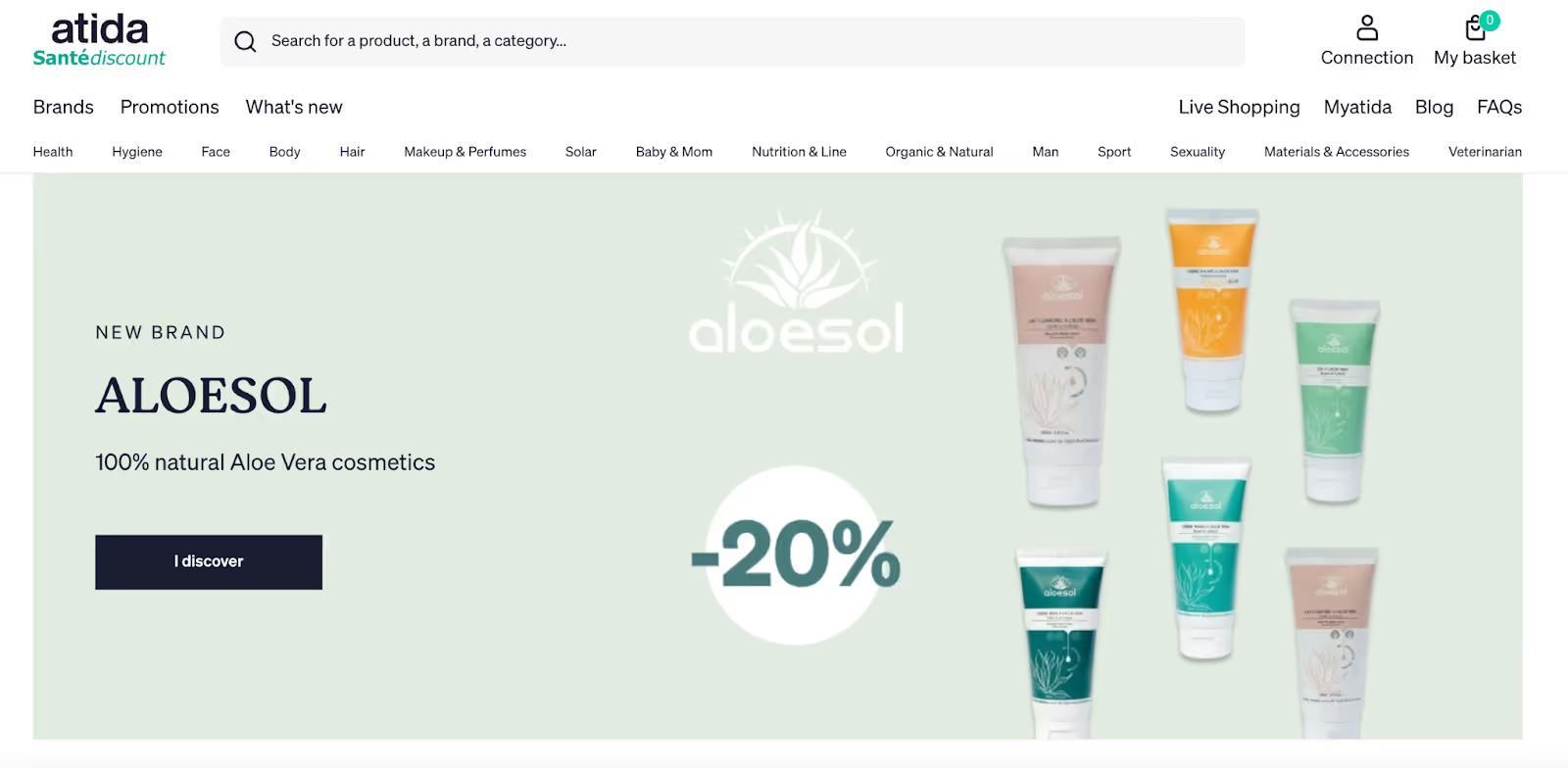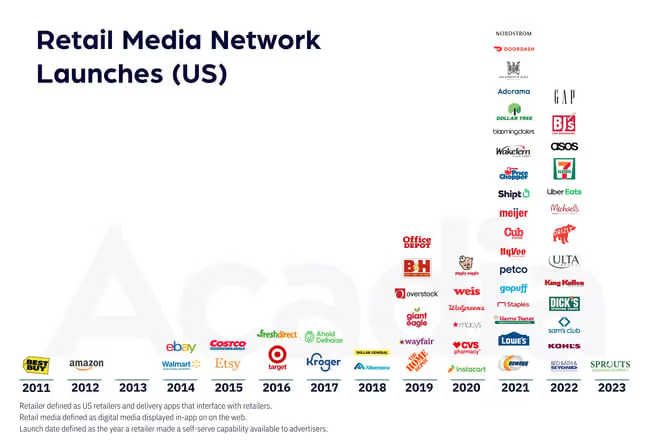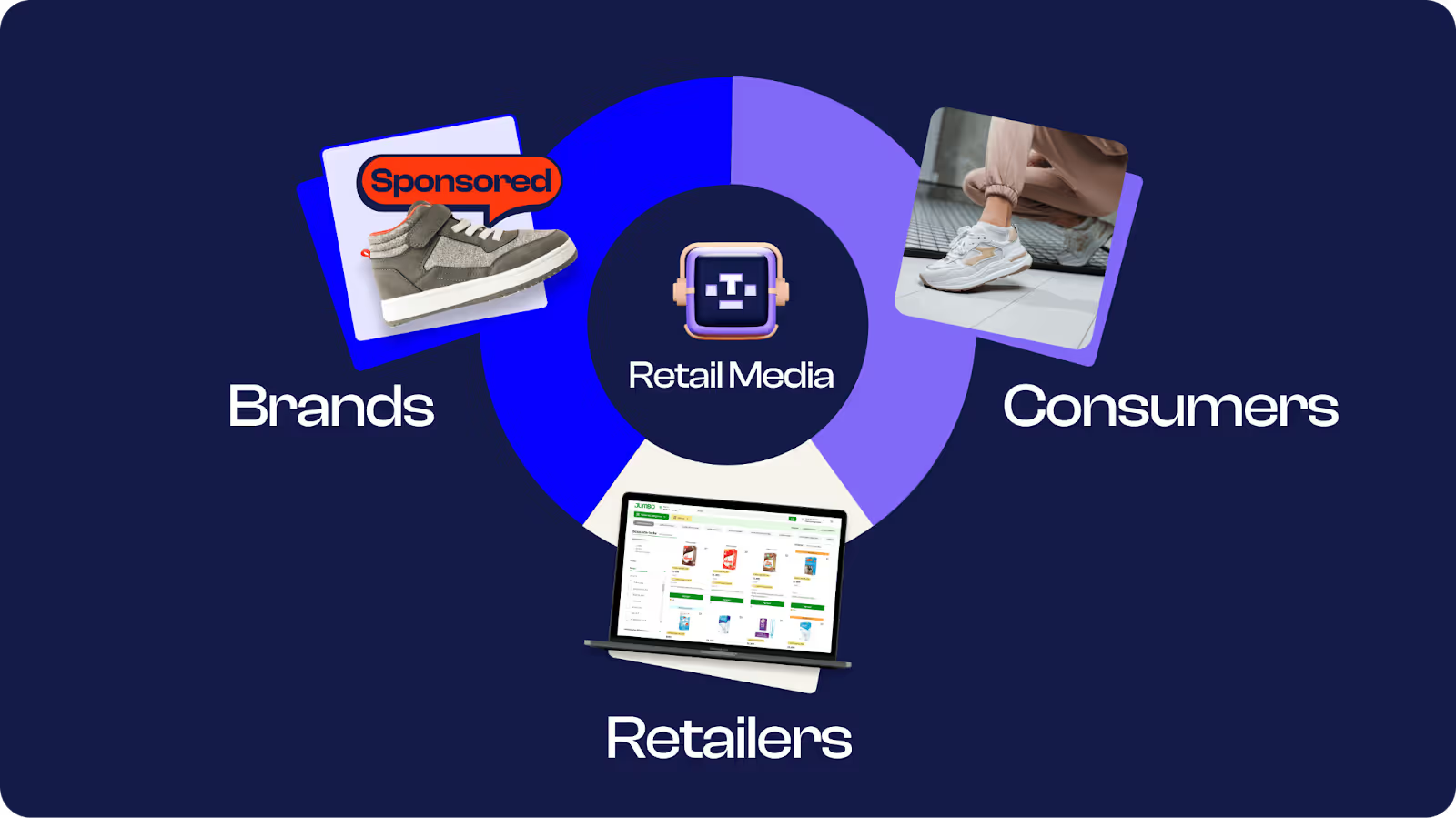
The advertising landscape is undergoing a significant transformation with the rise of Retail Media as the predominant trend of the decade. According to eMarketer, worldwide retail media spend will hit $140 billion in 2024. Digital advertising is nothing new, but this channel is revolutionizing how well it’s being done. In an age when online shopping is widely popular and third-party cookies are disappearing, businesses that use retail media are not only ahead of the curve, but also protecting and enhancing customer experiences.
In this guide you'll discover what retail media means today, why it’s growing so rapidly and next steps for those looking to not just join, but excel among the retail media crowd.
What is Retail Media?
Retail media refers to the advertising within retailer sites and apps, also called Onsite advertising. By building their own retail media networks, brands can promote their products on a “digital shelf”.
Retail media Onsite often appear as native ads or display ads. These ads can appear on different pages within retailer platforms, such as the home page, category page, search results page, or product detail page, effectively targeting consumers at different stages of their shopping journey. There are three main types:
- Sponsored products: Listings within search for relevant products
- Sponsored brands: Banner ads within search results
- Display ads: Banner ads that follow customers across the website, like on the homepage
They may see ads within search for a specific product and banner ads now and in the future for a given brand. These ads are close to the point of purchase. This type of native ads seamlessly integrate into search results, resembling regular products but are marked with a subtle "sponsored" label. Here is an example of how they could look like:

Display ads offer more visually striking designs, blending brand messaging with dynamic features like real-time pricing.

Additionally, some retail media solutions extend advertising reach beyond retailer platforms to the wider web through retargeting strategies, known as offsite retail media. This type leverage retailer data but are served through partnerships.
- Third-party sites mean the ad types are limited, but the IAB calls out web, app, display, audio, digital video, digital out-of-home (DOOH), and in-game.
- Social media and connected TV (CTV) ads are also considered off-site display ads, and are supported by partnerships such as the ones between Dollar General and Meta or Albertsons Companies and Omnicom Media Group. CTV is one area where Amazon in particular has immense retail media potential through Prime Video and Freevee.
- These ads are still considered retail media because brands leverage retail media networks’ partnerships and data to buy the ads, resulting in better targeting and measurement capabilities.
In-store digital advertising refers to the new era of targeted ads in brick-and-mortar, which can target customers, increase sales, and leverage consumer data in real life.
Why is retail media advertising hot right now?
- E-commerce Growth: The rise in e-commerce propels retail media, with brands seeking to capture the attention of consumers moving from physical stores to online shopping.
- The death of cookies: In a landscape moving beyond third-party cookies, advertisers turn to retailers' rich first-party data for targeted, personalized marketing.
Analysis shows retail media is being built in half the time it took to build search, and social media! In the past years, the number of retailers launching retail media networks has also exploded, showing how the market is opening new opportunities beyond just the big players.

The benefits of the Retail Media Ecosystem
Retail media isn't just about ads; it's about enhancing the shopping experience for customers, boosting revenue for retailers, and maximizing ROI for vendors. It's a win-win-win for everyone involved.

For Customers:
- Native ads blend to make the shopping experience non-intrusive
- A personalized shopping journey means customers find what they want without feeling bombarded by irrelevant ads.
- First-party data ensures customer information is protected. With retail media personalization doesn't mean sacrificing privacy.
For Retailers:
- Tapping into their valuable first-party data by having their Retail Media Platforms can boost revenue and Gross Merchandise Value (GMV).
For Vendors:
- Reach customers at their "I want to buy" moment with personalized and targeted ads.
- Increased brand awareness through retail media ads.
- Optimized ad spend leads to higher conversions and return on investment.
- Diversified advertising opportunities beyond major retail giants like Amazon, Walmart, and Target.
- "Closing the loop" between sales and marketing data allows vendors to track ad spend down to the SKU level, aiding in better forecasting and campaign agility.
Starting in 2024, and through at least 2027, Retail Media will be the fastest-growing format. If you're a retailer with your own e-commerce site, what are you waiting for?
What It Takes to Build a Retail Media Network?
Launching a retail media platform offers various approaches, essentially boiling down to the decision between "build versus buy”.
Companies such as Amazon, Walmart, and Instacart have developed their retail media platforms independently, a task that, while beneficial, requires considerable investment in both time and resources.
Delaying the launch for years could lead to significant losses in revenue, and constructing these solutions from scratch is a lengthy process. Aditionally, the challenge of not having enough engineering talent is notable; giants like Amazon and Facebook employ large teams of advertising engineers focused on building and improving their ad products.
With Topsort Retail media isn’t a build vs buy decision…
We specialize in AI for Auction tools and New Age Infrastructure to help brands tap into the same technology that made companies like Google and Amazon astronomical advertising profits for decades.
Some competitors like Kevel use APIs to build a retail media platform, others like Criteo or Citrus Ad have a standardized Retail Media Solution, at Topsort we have all the options.
With our most complete stack of tools and features, you can build your own retail media network in just weeks, at your own terms.
Our offering include a All-in-One platform or APIs we allow brands to:
- Use Topsort Groundbreaking BIDLESS™ auction technology
- Have simple integration & easily configurable ad formats with Real time Analytics
- End-to-end ad attribution/tracking & full reporting
- Self-Service Campaign Tools to empower sellers
- Campaign and Budgeting features to empower teams at scale
With retail media expected to be a $61 billion dollar industry by 2024, the time to launch yours is now. Talk to an expert and get started!


